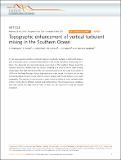Topographic enhancement of vertical turbulent mixing in the Southern Ocean
Author(s)
Garabato, A. Naveira; Mashayekhi, Alireza; Ferrari, Raffaele; Merrifield, Sophia Tiare; Ledwell, James R; St.Laurent, Louis C.; ... Show more Show less
DownloadTopographic enhancement.pdf (1.775Mb)
PUBLISHER_CC
Publisher with Creative Commons License
Creative Commons Attribution
Terms of use
Metadata
Show full item recordAbstract
It is an open question whether turbulent mixing across density surfaces is sufficiently large to play a dominant role in closing the deep branch of the ocean meridional overturning circulation. The diapycnal and isopycnal mixing experiment in the Southern Ocean found the turbulent diffusivity inferred from the vertical spreading of a tracer to be an order of magnitude larger than that inferred from the microstructure profiles at the mean tracer depth of 1,500 m in the Drake Passage. Using a high-resolution ocean model, it is shown that the fast vertical spreading of tracer occurs when it comes in contact with mixing hotspots over rough topography. The sparsity of such hotspots is made up for by enhanced tracer residence time in their vicinity due to diffusion toward weak bottom flows. The increased tracer residence time may explain the large vertical fluxes of heat and salt required to close the abyssal circulation.
Date issued
2017-03Department
Massachusetts Institute of Technology. Department of Earth, Atmospheric, and Planetary Sciences; Woods Hole Oceanographic InstitutionJournal
Nature Communications
Publisher
Nature Publishing Group
Citation
Mashayek, A.; Ferrari, R.; Merrifield, S.; Ledwell, J. R.; St Laurent, L. and Garabato, A. Naveira. “Topographic Enhancement of Vertical Turbulent Mixing in the Southern Ocean.” Nature Communications 8 (March 2017): 14197 © 2017 The Authors
Version: Final published version
ISSN
2041-1723